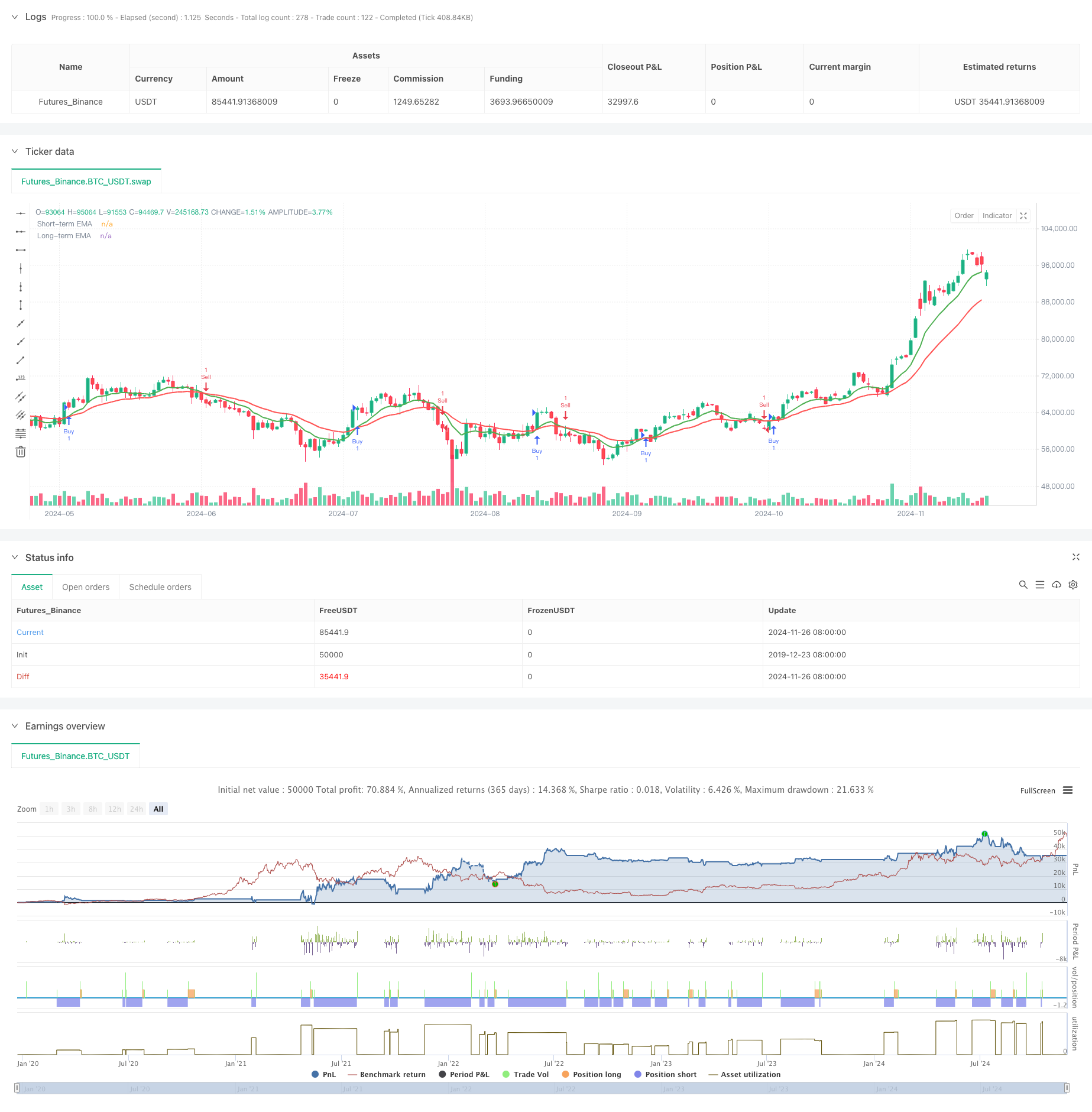Dynamic Dual Moving Average Crossover Quantitative Trading Strategy
Author: ChaoZhang, Date: 2024-11-28 17:15:28Tags: EMAMASMAMACDRSI

Overview
This is a quantitative trading strategy based on the EMA indicator, which makes trading decisions by calculating the crossover signals of short-term (9-period) and long-term (21-period) exponential moving averages. The strategy includes stop-loss and take-profit conditions set at 2% and 4% respectively to control risk and lock in profits. The core idea is to capture market trend turning points through moving average crossovers, enabling timely buy and sell operations when market trends change.
Strategy Principles
The strategy employs two exponential moving averages (EMA) with different periods: 9-period and 21-period. A buy signal is generated when the short-term EMA crosses above the long-term EMA, while a sell signal is triggered when the short-term EMA crosses below the long-term EMA. The strategy incorporates risk management mechanisms through 2% stop-loss and 4% take-profit levels to protect capital and secure gains. The short-term moving average is more sensitive to price changes, while the long-term moving average reflects longer-term trends, making their crossovers effective in capturing market trend transitions.
Strategy Advantages
- Clear operational rules and signals, easy to execute and backtest
- Effective risk control through stop-loss and take-profit settings
- Automatically adapts to market volatility without manual intervention
- Simple calculations with high execution efficiency
- Applicable to different time periods and market environments
- Clear code structure, easy to maintain and optimize
- Good scalability, can incorporate additional technical indicators for optimization
Strategy Risks
- May generate frequent false breakout signals in choppy markets
- Moving averages have inherent lag, potentially missing important market turning points
- Fixed stop-loss and take-profit parameters may not suit all market conditions
- Trading costs not considered, actual returns may be lower than backtest results
- Frequent stop-losses may be triggered in highly volatile markets
- Market liquidity risk not addressed
- Lack of consideration for macro market conditions
Strategy Optimization Directions
- Introduce volatility indicators for dynamic adjustment of stop-loss and take-profit parameters
- Add volume indicators to improve signal reliability
- Incorporate trend confirmation indicators like RSI or MACD
- Dynamically adjust moving average periods based on market conditions
- Add position management mechanisms for dynamic capital allocation
- Implement market condition assessment for parameter adjustment
- Consider trading costs and optimize trading frequency
Summary
This strategy is a classic trend-following approach that captures market trend changes through moving average crossovers. While relatively simple in design, it includes complete trading logic and risk control mechanisms. The strategy’s stability and profitability can be further enhanced through optimization measures such as dynamic parameter adjustment and market condition assessment. In practical application, it is recommended to optimize parameters based on specific trading instruments and market conditions while maintaining proper risk control.
/*backtest
start: 2019-12-23 08:00:00
end: 2024-11-27 00:00:00
period: 1d
basePeriod: 1d
exchanges: [{"eid":"Futures_Binance","currency":"BTC_USDT"}]
*/
// This Pine Script™ code is subject to the terms of the Mozilla Public License 2.0 at https://mozilla.org/MPL/2.0/
// © ancour
//@version=5
strategy("Moving Average Crossover", overlay=true)
// Define the length for short-term and long-term EMAs
shortEmaLength = 9
longEmaLength = 21
// Calculate EMAs
shortEma = ta.ema(close, shortEmaLength)
longEma = ta.ema(close, longEmaLength)
// Plot EMAs on the chart
plot(shortEma, title="Short-term EMA", color=color.green, linewidth=2)
plot(longEma, title="Long-term EMA", color=color.red, linewidth=2)
// Strategy conditions for crossovers
longCondition = ta.crossover(shortEma, longEma)
shortCondition = ta.crossunder(shortEma, longEma)
// Enter long when short EMA crosses above long EMA
if (longCondition)
strategy.entry("Buy", strategy.long)
// Exit long or enter short when short EMA crosses below long EMA
if (shortCondition)
strategy.entry("Sell", strategy.short)
// Optional: Add stop-loss and take-profit levels for risk management
stopLossPercent = 2
takeProfitPercent = 4
strategy.exit("Sell TP/SL", "Buy", stop=low * (1 - stopLossPercent/100), limit=high * (1 + takeProfitPercent/100))
- Multi-Timeframe EMA Cross High-Win Rate Trend Following Strategy (Advanced)
- Multi-Strategy Technical Analysis Trading System
- Quantitative Long-Short Switching Strategy Based on G-Channel and EMA
- Multi-Level Dynamic MACD Trend Following Strategy with 52-Week High/Low Extension Analysis System
- Multi-EMA Dynamic Trend Capture Quantitative Trading Strategy
- Multi-Technical Indicator Synergistic Trading System
- No Upper Wick Bullish Candle Breakout Strategy
- Elliott Wave Theory 4-9 Impulse Wave Automatic Detection Trading Strategy
- Dual Dynamic Indicator Optimization Strategy
- Dynamic Multi-Period Exponential Moving Average Cross Strategy with Pullback Optimization System
- Multi-Frequency Momentum Reversal Quantitative Strategy System
- Automated Quantitative Trading System with Dual EMA Crossover and Risk Management
- Dynamic Dual-SMA Trend Following Strategy with Smart Risk Management
- KNN-Based Adaptive Parametric Trend Following Strategy
- Multi-Period Trend Following Trading System Based on EMA Volatility Bands
- Random bidding generator for the retesting system
- Multi-Timeframe EMA Cross High-Win Rate Trend Following Strategy (Advanced)
- Adaptive Range Volatility Trend Following Trading Strategy
- Dual Moving Average Trend Following Trading System with Risk-Reward Ratio Optimization Strategy
- Moving Average Crossover and Candlestick Pattern Smart Timing Strategy
- Bollinger Bands and RSI Combined Trading Strategy
- Multi-EMA Trend Following Strategy with Dynamic ATR Targets
- Elder's Force Index Quantitative Trading Strategy Based on Standard Deviation and Moving Averages
- ATR Fusion Trend Optimization Model Strategy
- Enhanced Multi-Indicator Trend Reversal Intelligence Strategy
- RSI Trend Momentum Trading Strategy with Dual MA and Volume Confirmation
- Triple EMA Crossover Trading Strategy with Dynamic Stop-Loss and Take-Profit
- Dual Momentum Squeeze Trading System (SMI+UBS Indicator Combination Strategy)
- RSI-MACD Multi-Signal Trading System with Dynamic Stop Management
- ADX Trend Breakout Momentum Trading Strategy